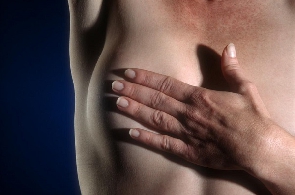 Breasts should be checked regularly for early detection of cancer
Breasts should be checked regularly for early detection of cancer
It’s an undeniable fact, the role of a woman’s breast in the life of a man. You could say, men, just like babies, like breasts. Breasts are as important to women, as it is to men.
It is still a mystery the exact ‘drawing’ factor between men and breasts but Larry Young, one of the world’s leading experts in the neuroscience of social bonding has attributed it to brain organization and brain mechanisms.
Per his research, attraction to breasts "is a brain organization effect that occurs in straight males when they go through puberty. Evolution has selected for this brain organization in men that makes them attracted to the breasts in a sexual context, because the outcome is that it activates the female bonding circuit, making women feel more bonded with him.”
In his book titled, “The chemistry between us: Love, sex and the science of attraction,” he notes how the brain works to release oxytocin, a hormone secreted by the posterior lobe of the pituitary gland when people snuggle up or bond socially.
Vital as it is, it is relevant that the breast is checked by women constantly to ensure they are safe from irregularities and cancerous tumors.
But what is the man’s role, husbands specifically in ensuring that the ‘treasure’ they so adore, is healthy at all times and that their wives are safe from the deadly breast cancer?
Breast cancer is a cancer that develops from breast tissue. Its symptoms vary widely; from lumps to swelling, to skin changes, and many breast cancers have no obvious symptoms at all. In other cases, however, the first sign of breast cancer is a new lump or mass in the breast that you or your doctor can feel. A lump that is painless, hard, and has uneven edges is more likely to be cancerous. But sometimes cancers can be tender, soft, and rounded.
Women are advised to have breast examinations every one to three years and then every year once they turn 40.
Screening is an important way of early detection but self-examination is more often than not also advised, this is where the men come in.
As part of efforts to champion the breast cancer awareness campaign, www.ghanaweb.com outlines tips for men to help check their wives’ breasts to ensure they are fit every time:
Look out for the following in your wife’s breast
1) In the Shower
Using the pads of your fingers, move around her entire breast in a circular pattern moving from the outside to the center, checking the entire breast and armpit area.
• Check both breasts each month feeling for any lump, thickening, or hardened knot.
2) In Front of a Mirror
• Visually inspect her breasts whiles both her arms are at her sides.
• With her arms high over her head, repeat the same, look for changes visually.
• Look for any changes in the contour, any swelling, or dimpling of the skin, or changes in the nipples.
• Next, observe for any changes as she rests her palms on her hips and presses firmly to flex her chest muscles. Left and right breasts will not exactly match—few women’s breasts do, so look for any dimpling, puckering, or changes, particularly on one side.
3) Lying Down
• When lying down, the breast tissue spreads out evenly along the chest wall. Place a pillow under her right shoulder and have her place her right arm behind her head.
• Using your left hand, move the pads of your fingers around her right breast gently in small circular motions covering the entire breast area and armpit.
• Use light, medium, and firm pressure. Squeeze the nipple; check for discharge and lumps. Repeat these steps for her left breast.
Common signs of breast cancer:
A change in the size, outline or shape of your breast
A change in the look or feel of your skin, such as puckering or dimpling
A new lump, thickening or bumpy area in one breast or armpit that is different from the same area on the other side
Nipple discharge that's not milky
Bleeding from your nipple
A moist, red area on your nipple that doesn't heal easily
Any change in nipple position, such as your nipple being pulled in or pointing differently
A rash on or around your nipple
Any discomfort or pain in one breast, particularly if it's a new pain and doesn't go away (although pain is only a symptom of breast cancer in rare cases)
Please note: Go with your wife as soon as possible to the health center if any unusual changes are detected.